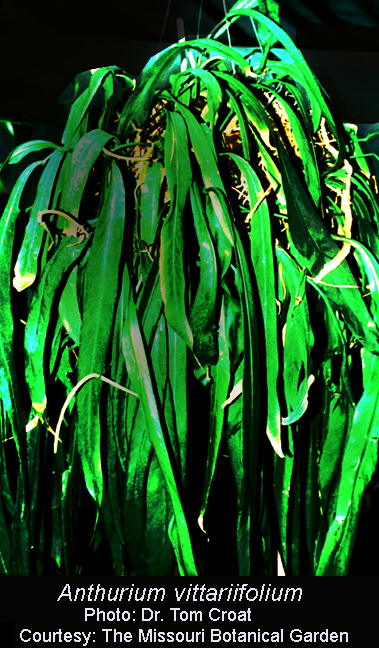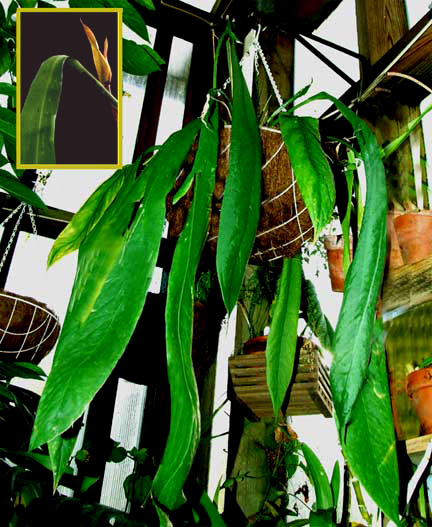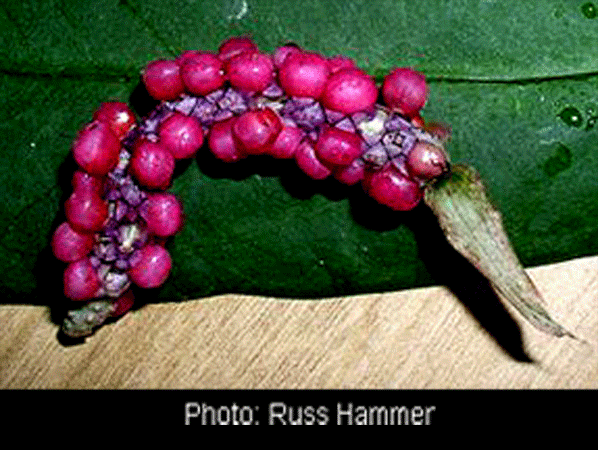![]()
Aroids and other genera in the Collection
Take the Tour Now?
Orchids
The
Exotic Rainforest
Plants in
the Exotic Rainforest Collection
The images on this website are copyright protected. Please contact us before any reuse.
Detailed information on Growing Anthurium
Species Click this Link
Within our collection we have many species of Anthurium. If you are seeking other photos, click this link:
Anthurium vittariifolium Engl.

Anthurium
vittariifolium
Engl.
Anthurium vittariifolium
(vita-AR-E-EYE-fo-lee-um) is a strap leaf anthurium that can reach
large proportions. The tree dwelling epiphyte can develop 7 to
10cm wide (3 to
4 inch) wide leaves that reportedly grow to 2.4 meters (8 feet) long
 making it one
super-sized plant when fully grown. Anthurium vittariifolium
appreciates filtered sunlight that is
bright and
requires excellent drainage in a soil mixture that stays damp but not
soggy.
making it one
super-sized plant when fully grown. Anthurium vittariifolium
appreciates filtered sunlight that is
bright and
requires excellent drainage in a soil mixture that stays damp but not
soggy.
 making it one
super-sized plant when fully grown. Anthurium vittariifolium
appreciates filtered sunlight that is
bright and
requires excellent drainage in a soil mixture that stays damp but not
soggy.
making it one
super-sized plant when fully grown. Anthurium vittariifolium
appreciates filtered sunlight that is
bright and
requires excellent drainage in a soil mixture that stays damp but not
soggy.
A. vittariifolium
is properly considered a part of Anthurium section
Urospadix . Species in that section have short stems
with short internodes and generally epunctate leaf blades which are
typically much longer than broad leaf blades that are typically
lanceolate (spear shaped).
Anthurium differ from
Philodendron species since all Anthurium produce perfect
flowers containing both male and female organs while Philodendron
produce imperfect flowers containing only a single sex. At
sexual anthesis all Anthurium produce an inflorescence which
contains both a spathe and a spadix. The spadix is only a modified
leaf and not a flower which surrounds the fleshy spike known as the
spadix. When an
Anthurium is "in flower" the reference is to the tiny flowers
containing both male and female sexual parts that grow on the spadix at
the center of the inflorescence. To help prevent self pollination nature has
designed the female flowers to be receptive before the male portion of
the flower
produce their pollen so in most cases an insect must bring pollen from
another plant. If the
female flowers are pollinated they will eventually produce berries which
contain seeds. For more information on the sexual reproduction of
an aroid see the link below.
 We prefer a combination of good potting soil, peat, orchid bark,
Perlite, and crushed volcanic rock. A rain forest plant, this
species should be watered often and housed in humid conditions.
A. vittariifolium produces a small pinkish spathe
and
inflorescence that is attractive but unremarkable. The berries are
a bright violet/pink. (See inset photos).
According to TROPICOS (Missouri Botanical Garden) the plant has been
collected in Colombia, Brazil, Ecuador and Peru. Very little information has been published about this species other than
it is a native of the this region of South America. Our specimen
currently (Jan, 06) has leaves of approximately 90cm (3 feet).
We prefer a combination of good potting soil, peat, orchid bark,
Perlite, and crushed volcanic rock. A rain forest plant, this
species should be watered often and housed in humid conditions.
A. vittariifolium produces a small pinkish spathe
and
inflorescence that is attractive but unremarkable. The berries are
a bright violet/pink. (See inset photos).
According to TROPICOS (Missouri Botanical Garden) the plant has been
collected in Colombia, Brazil, Ecuador and Peru. Very little information has been published about this species other than
it is a native of the this region of South America. Our specimen
currently (Jan, 06) has leaves of approximately 90cm (3 feet).
Anthurium species are known to
be highly variable and not every leaf of every specimen will always
appear the same. This link explains in greater detail the
scientific principle of natural variation and morphogenesis.
Click here.
Join the
International Aroid Society:
http://www.exoticrainforest.com/Join%20IAS.html
If you are seeking information on other rare
species, click on "Aroids and other genera in the Collection" at the top and look for
the
